Analysis of Breast Cancer Prevalence and Risk Factors in Australia
VerifiedAdded on 2022/11/13
|7
|1645
|234
Report
AI Summary
This report provides a comprehensive analysis of breast cancer prevalence and risk factors in Australia, focusing on a case study of a woman named Jade. It begins with an introduction to breast cancer, its prevalence, and the relevant epidemiological data. The report delves into the social and environmental determinants contributing to the disease, such as smoking, alcohol consumption, and lifestyle factors. It then explores the available services for people with breast cancer within the Australian health system, including Medicare, breast surgery, and follow-up care, followed by a critical evaluation of these services. The report concludes with recommendations for Jade's case, emphasizing the importance of lifestyle modifications and early detection through mammography, and suggests preventive services to reduce breast cancer incidence and mortality rates in Australia. The report references several studies and media articles to support its findings and recommendations.
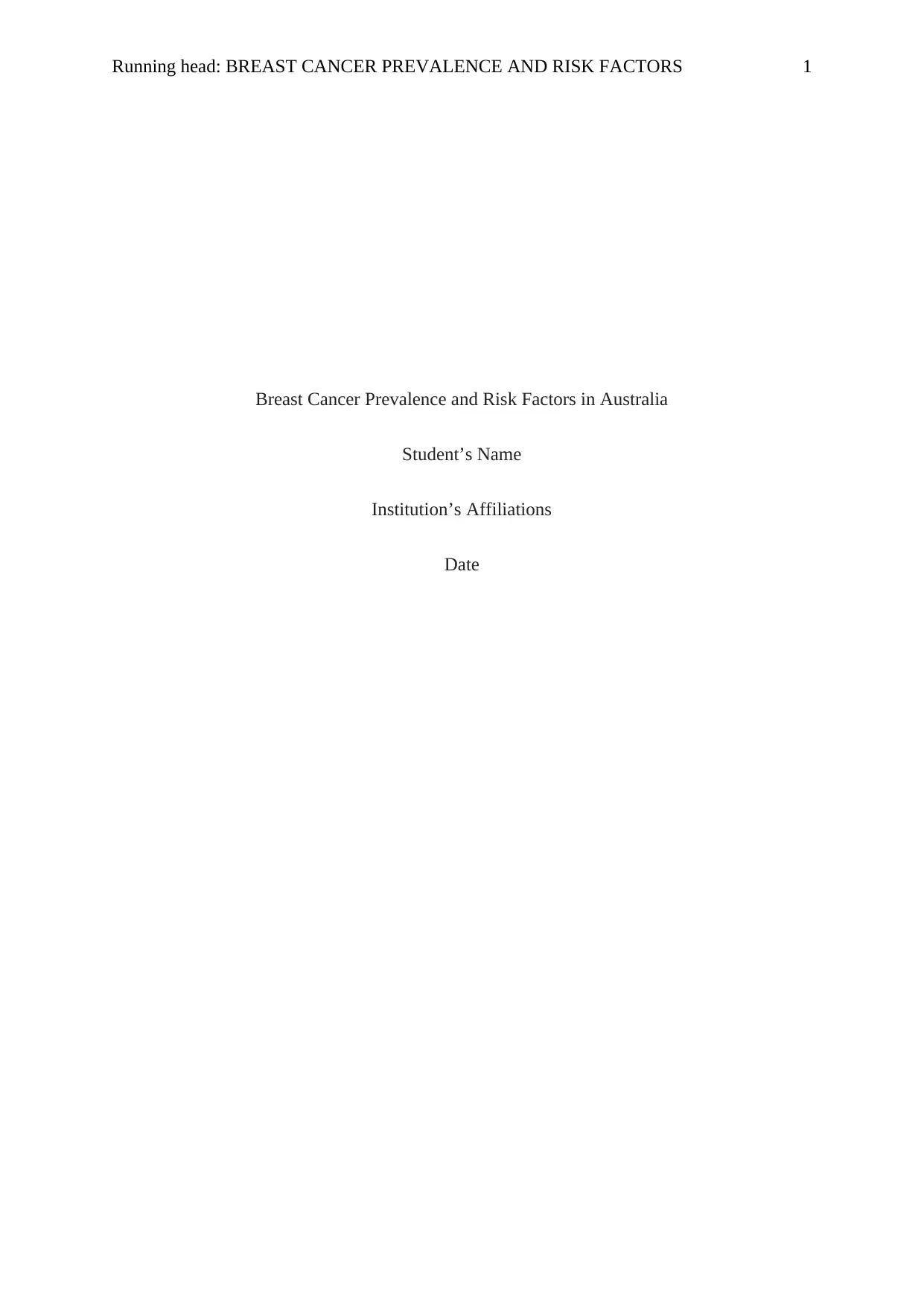
Running head: BREAST CANCER PREVALENCE AND RISK FACTORS 1
Breast Cancer Prevalence and Risk Factors in Australia
Student’s Name
Institution’s Affiliations
Date
Breast Cancer Prevalence and Risk Factors in Australia
Student’s Name
Institution’s Affiliations
Date
Paraphrase This Document
Need a fresh take? Get an instant paraphrase of this document with our AI Paraphraser
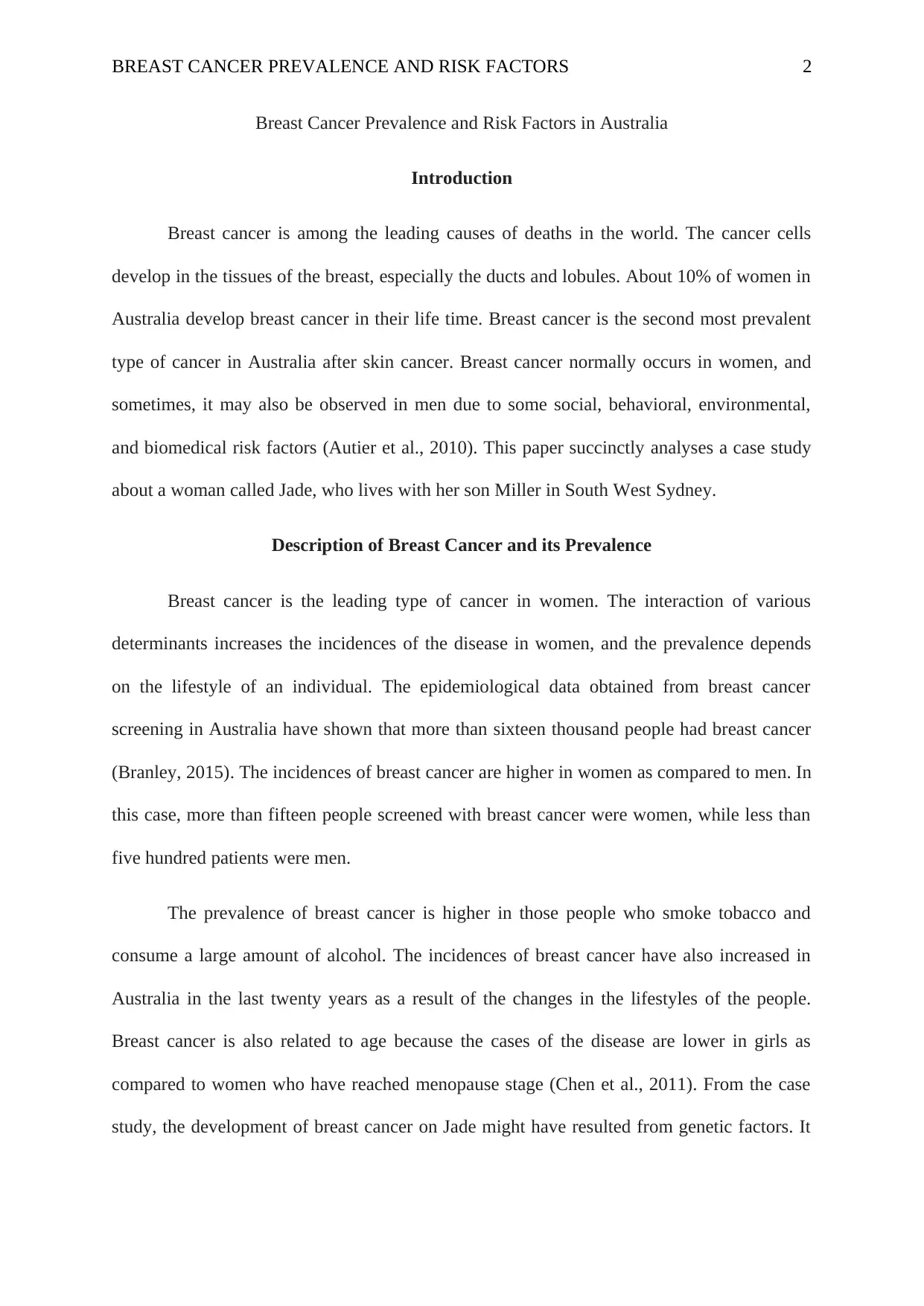
BREAST CANCER PREVALENCE AND RISK FACTORS 2
Breast Cancer Prevalence and Risk Factors in Australia
Introduction
Breast cancer is among the leading causes of deaths in the world. The cancer cells
develop in the tissues of the breast, especially the ducts and lobules. About 10% of women in
Australia develop breast cancer in their life time. Breast cancer is the second most prevalent
type of cancer in Australia after skin cancer. Breast cancer normally occurs in women, and
sometimes, it may also be observed in men due to some social, behavioral, environmental,
and biomedical risk factors (Autier et al., 2010). This paper succinctly analyses a case study
about a woman called Jade, who lives with her son Miller in South West Sydney.
Description of Breast Cancer and its Prevalence
Breast cancer is the leading type of cancer in women. The interaction of various
determinants increases the incidences of the disease in women, and the prevalence depends
on the lifestyle of an individual. The epidemiological data obtained from breast cancer
screening in Australia have shown that more than sixteen thousand people had breast cancer
(Branley, 2015). The incidences of breast cancer are higher in women as compared to men. In
this case, more than fifteen people screened with breast cancer were women, while less than
five hundred patients were men.
The prevalence of breast cancer is higher in those people who smoke tobacco and
consume a large amount of alcohol. The incidences of breast cancer have also increased in
Australia in the last twenty years as a result of the changes in the lifestyles of the people.
Breast cancer is also related to age because the cases of the disease are lower in girls as
compared to women who have reached menopause stage (Chen et al., 2011). From the case
study, the development of breast cancer on Jade might have resulted from genetic factors. It
Breast Cancer Prevalence and Risk Factors in Australia
Introduction
Breast cancer is among the leading causes of deaths in the world. The cancer cells
develop in the tissues of the breast, especially the ducts and lobules. About 10% of women in
Australia develop breast cancer in their life time. Breast cancer is the second most prevalent
type of cancer in Australia after skin cancer. Breast cancer normally occurs in women, and
sometimes, it may also be observed in men due to some social, behavioral, environmental,
and biomedical risk factors (Autier et al., 2010). This paper succinctly analyses a case study
about a woman called Jade, who lives with her son Miller in South West Sydney.
Description of Breast Cancer and its Prevalence
Breast cancer is the leading type of cancer in women. The interaction of various
determinants increases the incidences of the disease in women, and the prevalence depends
on the lifestyle of an individual. The epidemiological data obtained from breast cancer
screening in Australia have shown that more than sixteen thousand people had breast cancer
(Branley, 2015). The incidences of breast cancer are higher in women as compared to men. In
this case, more than fifteen people screened with breast cancer were women, while less than
five hundred patients were men.
The prevalence of breast cancer is higher in those people who smoke tobacco and
consume a large amount of alcohol. The incidences of breast cancer have also increased in
Australia in the last twenty years as a result of the changes in the lifestyles of the people.
Breast cancer is also related to age because the cases of the disease are lower in girls as
compared to women who have reached menopause stage (Chen et al., 2011). From the case
study, the development of breast cancer on Jade might have resulted from genetic factors. It
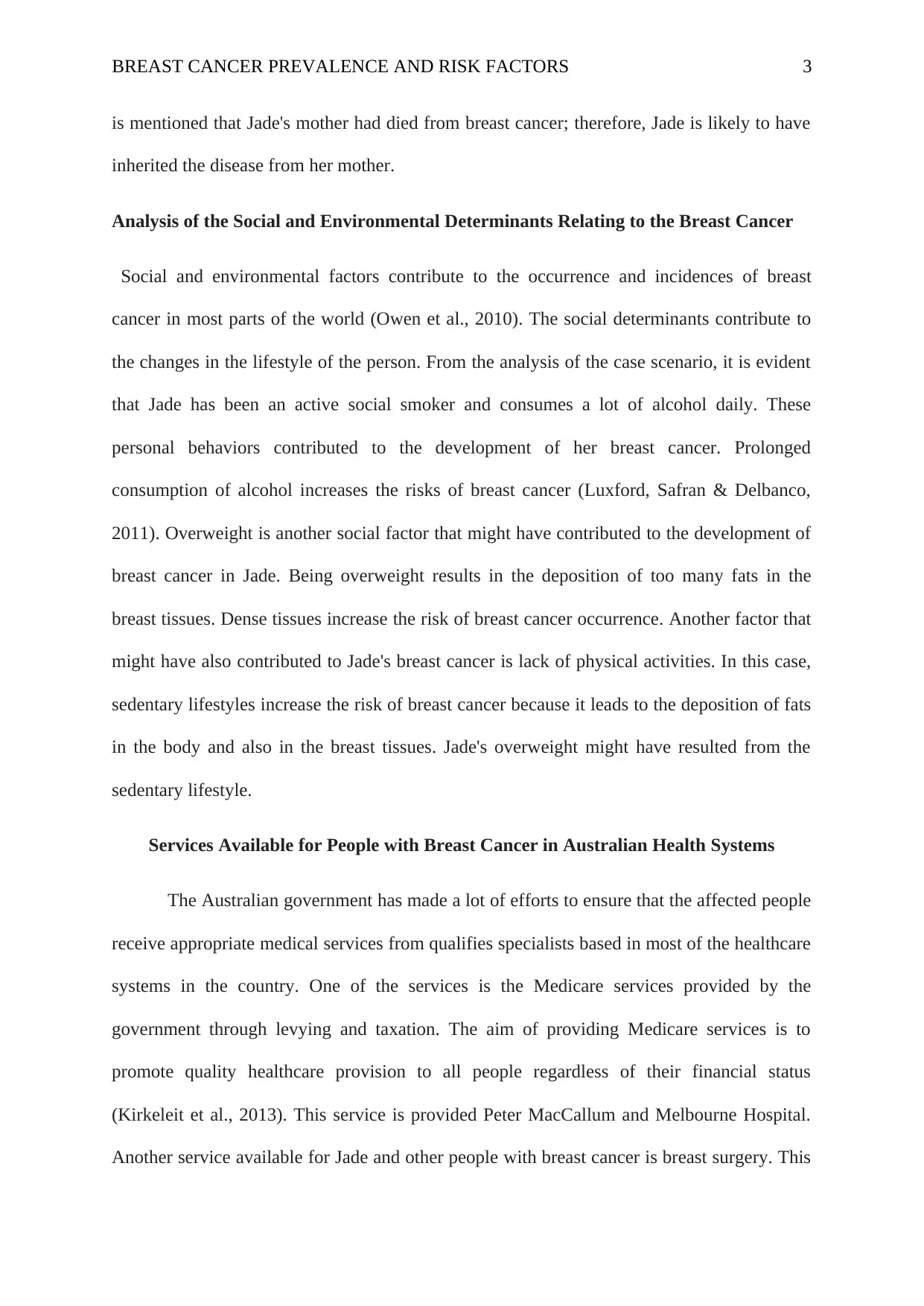
BREAST CANCER PREVALENCE AND RISK FACTORS 3
is mentioned that Jade's mother had died from breast cancer; therefore, Jade is likely to have
inherited the disease from her mother.
Analysis of the Social and Environmental Determinants Relating to the Breast Cancer
Social and environmental factors contribute to the occurrence and incidences of breast
cancer in most parts of the world (Owen et al., 2010). The social determinants contribute to
the changes in the lifestyle of the person. From the analysis of the case scenario, it is evident
that Jade has been an active social smoker and consumes a lot of alcohol daily. These
personal behaviors contributed to the development of her breast cancer. Prolonged
consumption of alcohol increases the risks of breast cancer (Luxford, Safran & Delbanco,
2011). Overweight is another social factor that might have contributed to the development of
breast cancer in Jade. Being overweight results in the deposition of too many fats in the
breast tissues. Dense tissues increase the risk of breast cancer occurrence. Another factor that
might have also contributed to Jade's breast cancer is lack of physical activities. In this case,
sedentary lifestyles increase the risk of breast cancer because it leads to the deposition of fats
in the body and also in the breast tissues. Jade's overweight might have resulted from the
sedentary lifestyle.
Services Available for People with Breast Cancer in Australian Health Systems
The Australian government has made a lot of efforts to ensure that the affected people
receive appropriate medical services from qualifies specialists based in most of the healthcare
systems in the country. One of the services is the Medicare services provided by the
government through levying and taxation. The aim of providing Medicare services is to
promote quality healthcare provision to all people regardless of their financial status
(Kirkeleit et al., 2013). This service is provided Peter MacCallum and Melbourne Hospital.
Another service available for Jade and other people with breast cancer is breast surgery. This
is mentioned that Jade's mother had died from breast cancer; therefore, Jade is likely to have
inherited the disease from her mother.
Analysis of the Social and Environmental Determinants Relating to the Breast Cancer
Social and environmental factors contribute to the occurrence and incidences of breast
cancer in most parts of the world (Owen et al., 2010). The social determinants contribute to
the changes in the lifestyle of the person. From the analysis of the case scenario, it is evident
that Jade has been an active social smoker and consumes a lot of alcohol daily. These
personal behaviors contributed to the development of her breast cancer. Prolonged
consumption of alcohol increases the risks of breast cancer (Luxford, Safran & Delbanco,
2011). Overweight is another social factor that might have contributed to the development of
breast cancer in Jade. Being overweight results in the deposition of too many fats in the
breast tissues. Dense tissues increase the risk of breast cancer occurrence. Another factor that
might have also contributed to Jade's breast cancer is lack of physical activities. In this case,
sedentary lifestyles increase the risk of breast cancer because it leads to the deposition of fats
in the body and also in the breast tissues. Jade's overweight might have resulted from the
sedentary lifestyle.
Services Available for People with Breast Cancer in Australian Health Systems
The Australian government has made a lot of efforts to ensure that the affected people
receive appropriate medical services from qualifies specialists based in most of the healthcare
systems in the country. One of the services is the Medicare services provided by the
government through levying and taxation. The aim of providing Medicare services is to
promote quality healthcare provision to all people regardless of their financial status
(Kirkeleit et al., 2013). This service is provided Peter MacCallum and Melbourne Hospital.
Another service available for Jade and other people with breast cancer is breast surgery. This
⊘ This is a preview!⊘
Do you want full access?
Subscribe today to unlock all pages.

Trusted by 1+ million students worldwide
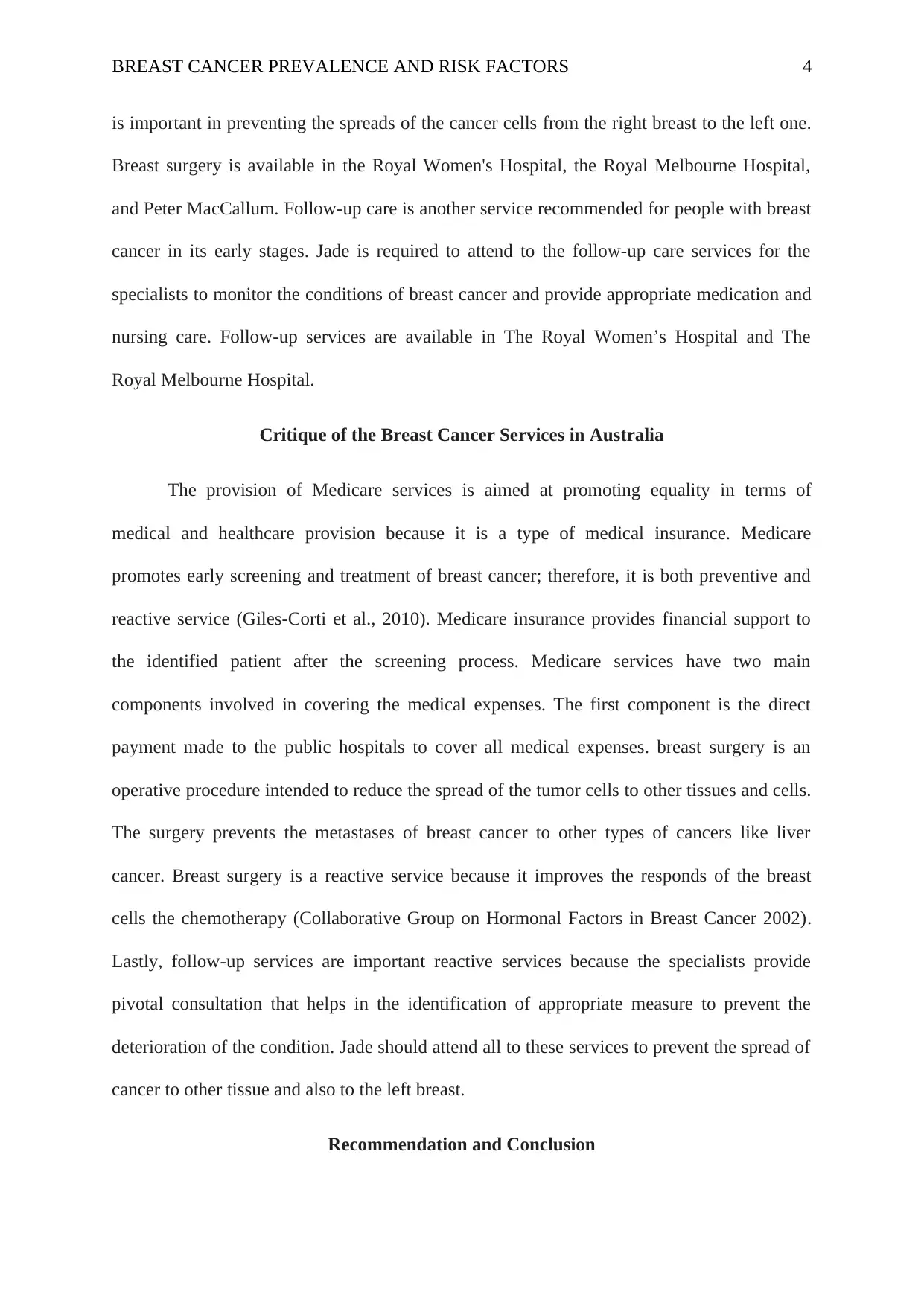
BREAST CANCER PREVALENCE AND RISK FACTORS 4
is important in preventing the spreads of the cancer cells from the right breast to the left one.
Breast surgery is available in the Royal Women's Hospital, the Royal Melbourne Hospital,
and Peter MacCallum. Follow-up care is another service recommended for people with breast
cancer in its early stages. Jade is required to attend to the follow-up care services for the
specialists to monitor the conditions of breast cancer and provide appropriate medication and
nursing care. Follow-up services are available in The Royal Women’s Hospital and The
Royal Melbourne Hospital.
Critique of the Breast Cancer Services in Australia
The provision of Medicare services is aimed at promoting equality in terms of
medical and healthcare provision because it is a type of medical insurance. Medicare
promotes early screening and treatment of breast cancer; therefore, it is both preventive and
reactive service (Giles-Corti et al., 2010). Medicare insurance provides financial support to
the identified patient after the screening process. Medicare services have two main
components involved in covering the medical expenses. The first component is the direct
payment made to the public hospitals to cover all medical expenses. breast surgery is an
operative procedure intended to reduce the spread of the tumor cells to other tissues and cells.
The surgery prevents the metastases of breast cancer to other types of cancers like liver
cancer. Breast surgery is a reactive service because it improves the responds of the breast
cells the chemotherapy (Collaborative Group on Hormonal Factors in Breast Cancer 2002).
Lastly, follow-up services are important reactive services because the specialists provide
pivotal consultation that helps in the identification of appropriate measure to prevent the
deterioration of the condition. Jade should attend all to these services to prevent the spread of
cancer to other tissue and also to the left breast.
Recommendation and Conclusion
is important in preventing the spreads of the cancer cells from the right breast to the left one.
Breast surgery is available in the Royal Women's Hospital, the Royal Melbourne Hospital,
and Peter MacCallum. Follow-up care is another service recommended for people with breast
cancer in its early stages. Jade is required to attend to the follow-up care services for the
specialists to monitor the conditions of breast cancer and provide appropriate medication and
nursing care. Follow-up services are available in The Royal Women’s Hospital and The
Royal Melbourne Hospital.
Critique of the Breast Cancer Services in Australia
The provision of Medicare services is aimed at promoting equality in terms of
medical and healthcare provision because it is a type of medical insurance. Medicare
promotes early screening and treatment of breast cancer; therefore, it is both preventive and
reactive service (Giles-Corti et al., 2010). Medicare insurance provides financial support to
the identified patient after the screening process. Medicare services have two main
components involved in covering the medical expenses. The first component is the direct
payment made to the public hospitals to cover all medical expenses. breast surgery is an
operative procedure intended to reduce the spread of the tumor cells to other tissues and cells.
The surgery prevents the metastases of breast cancer to other types of cancers like liver
cancer. Breast surgery is a reactive service because it improves the responds of the breast
cells the chemotherapy (Collaborative Group on Hormonal Factors in Breast Cancer 2002).
Lastly, follow-up services are important reactive services because the specialists provide
pivotal consultation that helps in the identification of appropriate measure to prevent the
deterioration of the condition. Jade should attend all to these services to prevent the spread of
cancer to other tissue and also to the left breast.
Recommendation and Conclusion
Paraphrase This Document
Need a fresh take? Get an instant paraphrase of this document with our AI Paraphraser
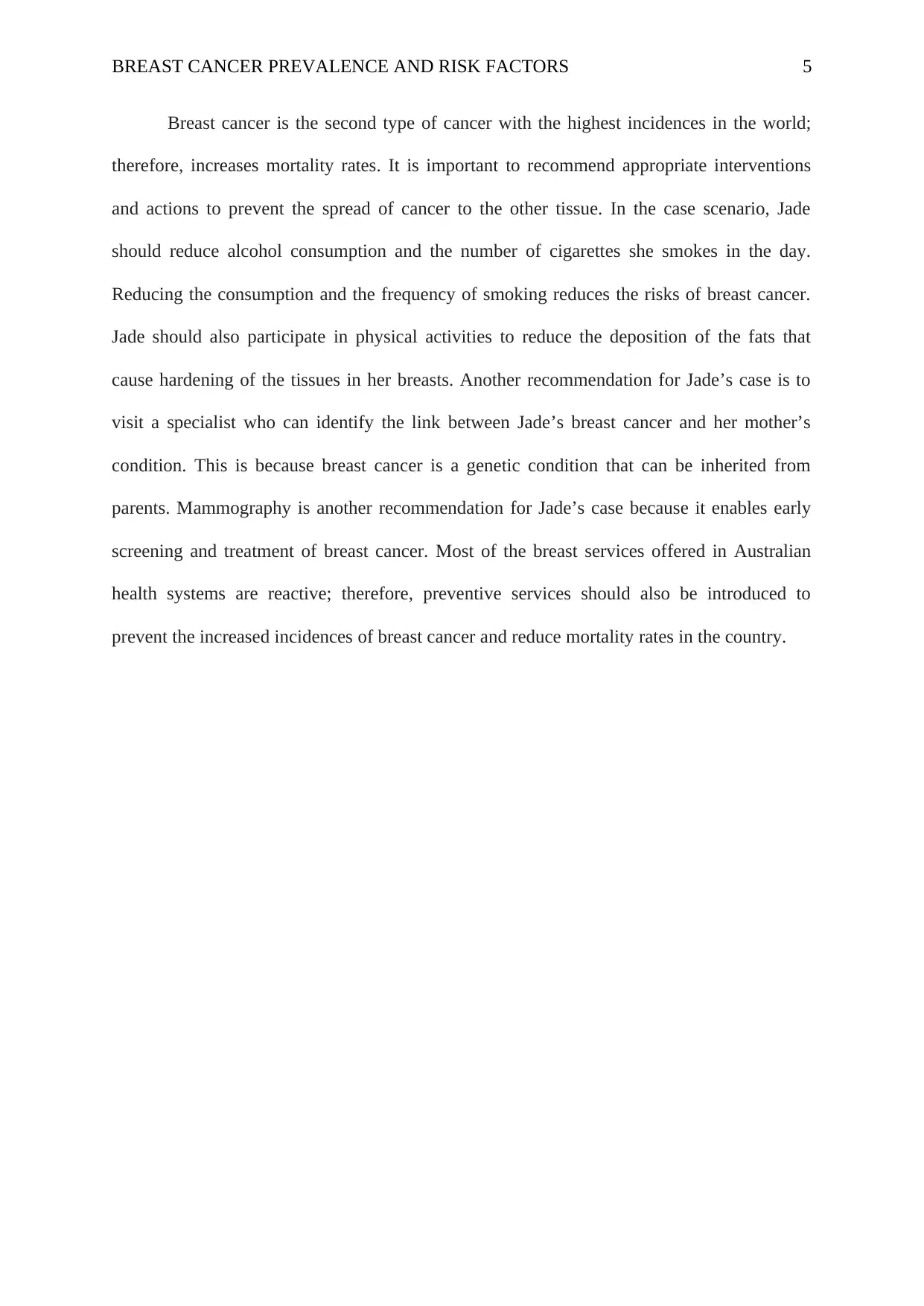
BREAST CANCER PREVALENCE AND RISK FACTORS 5
Breast cancer is the second type of cancer with the highest incidences in the world;
therefore, increases mortality rates. It is important to recommend appropriate interventions
and actions to prevent the spread of cancer to the other tissue. In the case scenario, Jade
should reduce alcohol consumption and the number of cigarettes she smokes in the day.
Reducing the consumption and the frequency of smoking reduces the risks of breast cancer.
Jade should also participate in physical activities to reduce the deposition of the fats that
cause hardening of the tissues in her breasts. Another recommendation for Jade’s case is to
visit a specialist who can identify the link between Jade’s breast cancer and her mother’s
condition. This is because breast cancer is a genetic condition that can be inherited from
parents. Mammography is another recommendation for Jade’s case because it enables early
screening and treatment of breast cancer. Most of the breast services offered in Australian
health systems are reactive; therefore, preventive services should also be introduced to
prevent the increased incidences of breast cancer and reduce mortality rates in the country.
Breast cancer is the second type of cancer with the highest incidences in the world;
therefore, increases mortality rates. It is important to recommend appropriate interventions
and actions to prevent the spread of cancer to the other tissue. In the case scenario, Jade
should reduce alcohol consumption and the number of cigarettes she smokes in the day.
Reducing the consumption and the frequency of smoking reduces the risks of breast cancer.
Jade should also participate in physical activities to reduce the deposition of the fats that
cause hardening of the tissues in her breasts. Another recommendation for Jade’s case is to
visit a specialist who can identify the link between Jade’s breast cancer and her mother’s
condition. This is because breast cancer is a genetic condition that can be inherited from
parents. Mammography is another recommendation for Jade’s case because it enables early
screening and treatment of breast cancer. Most of the breast services offered in Australian
health systems are reactive; therefore, preventive services should also be introduced to
prevent the increased incidences of breast cancer and reduce mortality rates in the country.
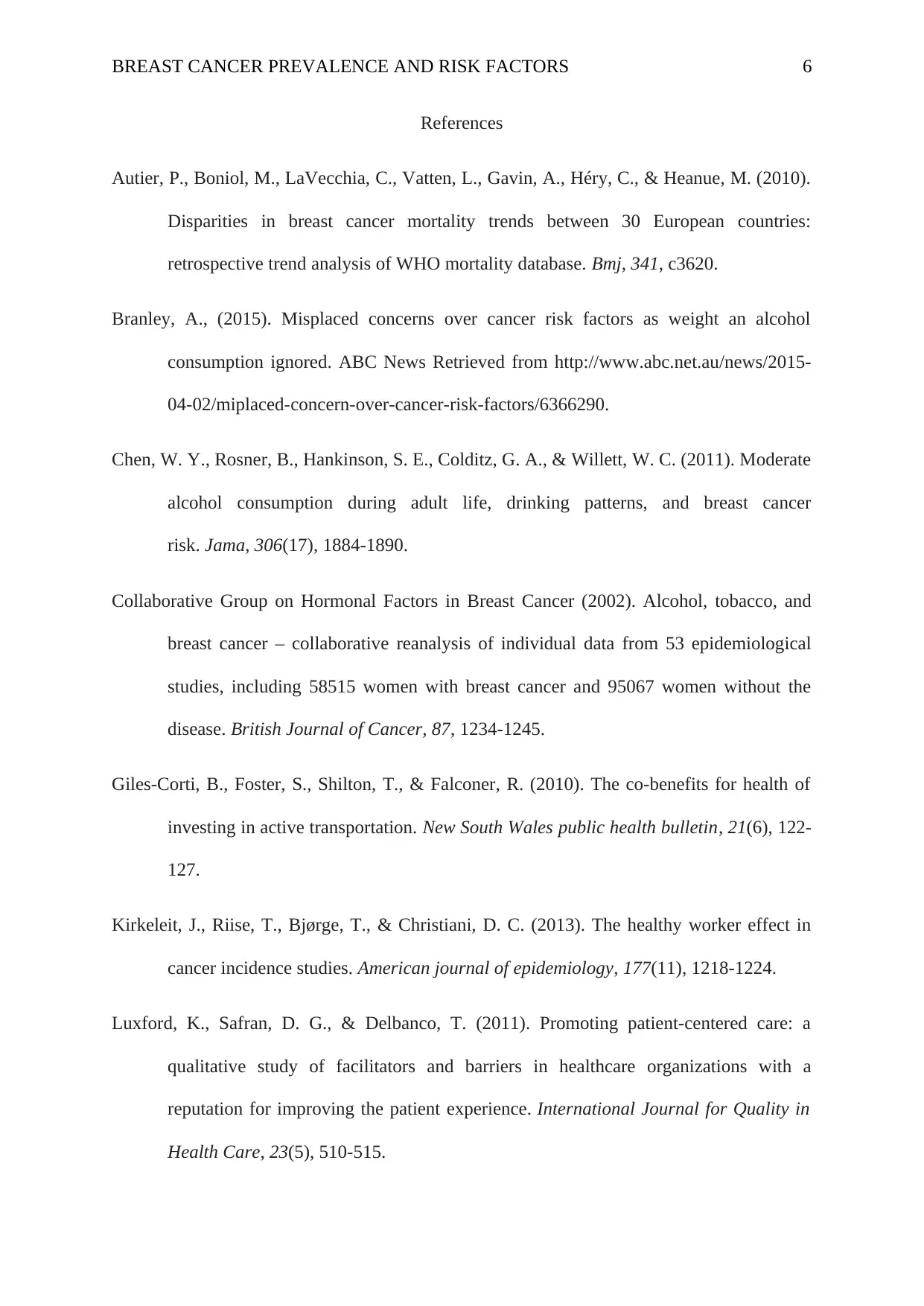
BREAST CANCER PREVALENCE AND RISK FACTORS 6
References
Autier, P., Boniol, M., LaVecchia, C., Vatten, L., Gavin, A., Héry, C., & Heanue, M. (2010).
Disparities in breast cancer mortality trends between 30 European countries:
retrospective trend analysis of WHO mortality database. Bmj, 341, c3620.
Branley, A., (2015). Misplaced concerns over cancer risk factors as weight an alcohol
consumption ignored. ABC News Retrieved from http://www.abc.net.au/news/2015-
04-02/miplaced-concern-over-cancer-risk-factors/6366290.
Chen, W. Y., Rosner, B., Hankinson, S. E., Colditz, G. A., & Willett, W. C. (2011). Moderate
alcohol consumption during adult life, drinking patterns, and breast cancer
risk. Jama, 306(17), 1884-1890.
Collaborative Group on Hormonal Factors in Breast Cancer (2002). Alcohol, tobacco, and
breast cancer – collaborative reanalysis of individual data from 53 epidemiological
studies, including 58515 women with breast cancer and 95067 women without the
disease. British Journal of Cancer, 87, 1234-1245.
Giles-Corti, B., Foster, S., Shilton, T., & Falconer, R. (2010). The co-benefits for health of
investing in active transportation. New South Wales public health bulletin, 21(6), 122-
127.
Kirkeleit, J., Riise, T., Bjørge, T., & Christiani, D. C. (2013). The healthy worker effect in
cancer incidence studies. American journal of epidemiology, 177(11), 1218-1224.
Luxford, K., Safran, D. G., & Delbanco, T. (2011). Promoting patient-centered care: a
qualitative study of facilitators and barriers in healthcare organizations with a
reputation for improving the patient experience. International Journal for Quality in
Health Care, 23(5), 510-515.
References
Autier, P., Boniol, M., LaVecchia, C., Vatten, L., Gavin, A., Héry, C., & Heanue, M. (2010).
Disparities in breast cancer mortality trends between 30 European countries:
retrospective trend analysis of WHO mortality database. Bmj, 341, c3620.
Branley, A., (2015). Misplaced concerns over cancer risk factors as weight an alcohol
consumption ignored. ABC News Retrieved from http://www.abc.net.au/news/2015-
04-02/miplaced-concern-over-cancer-risk-factors/6366290.
Chen, W. Y., Rosner, B., Hankinson, S. E., Colditz, G. A., & Willett, W. C. (2011). Moderate
alcohol consumption during adult life, drinking patterns, and breast cancer
risk. Jama, 306(17), 1884-1890.
Collaborative Group on Hormonal Factors in Breast Cancer (2002). Alcohol, tobacco, and
breast cancer – collaborative reanalysis of individual data from 53 epidemiological
studies, including 58515 women with breast cancer and 95067 women without the
disease. British Journal of Cancer, 87, 1234-1245.
Giles-Corti, B., Foster, S., Shilton, T., & Falconer, R. (2010). The co-benefits for health of
investing in active transportation. New South Wales public health bulletin, 21(6), 122-
127.
Kirkeleit, J., Riise, T., Bjørge, T., & Christiani, D. C. (2013). The healthy worker effect in
cancer incidence studies. American journal of epidemiology, 177(11), 1218-1224.
Luxford, K., Safran, D. G., & Delbanco, T. (2011). Promoting patient-centered care: a
qualitative study of facilitators and barriers in healthcare organizations with a
reputation for improving the patient experience. International Journal for Quality in
Health Care, 23(5), 510-515.
⊘ This is a preview!⊘
Do you want full access?
Subscribe today to unlock all pages.

Trusted by 1+ million students worldwide
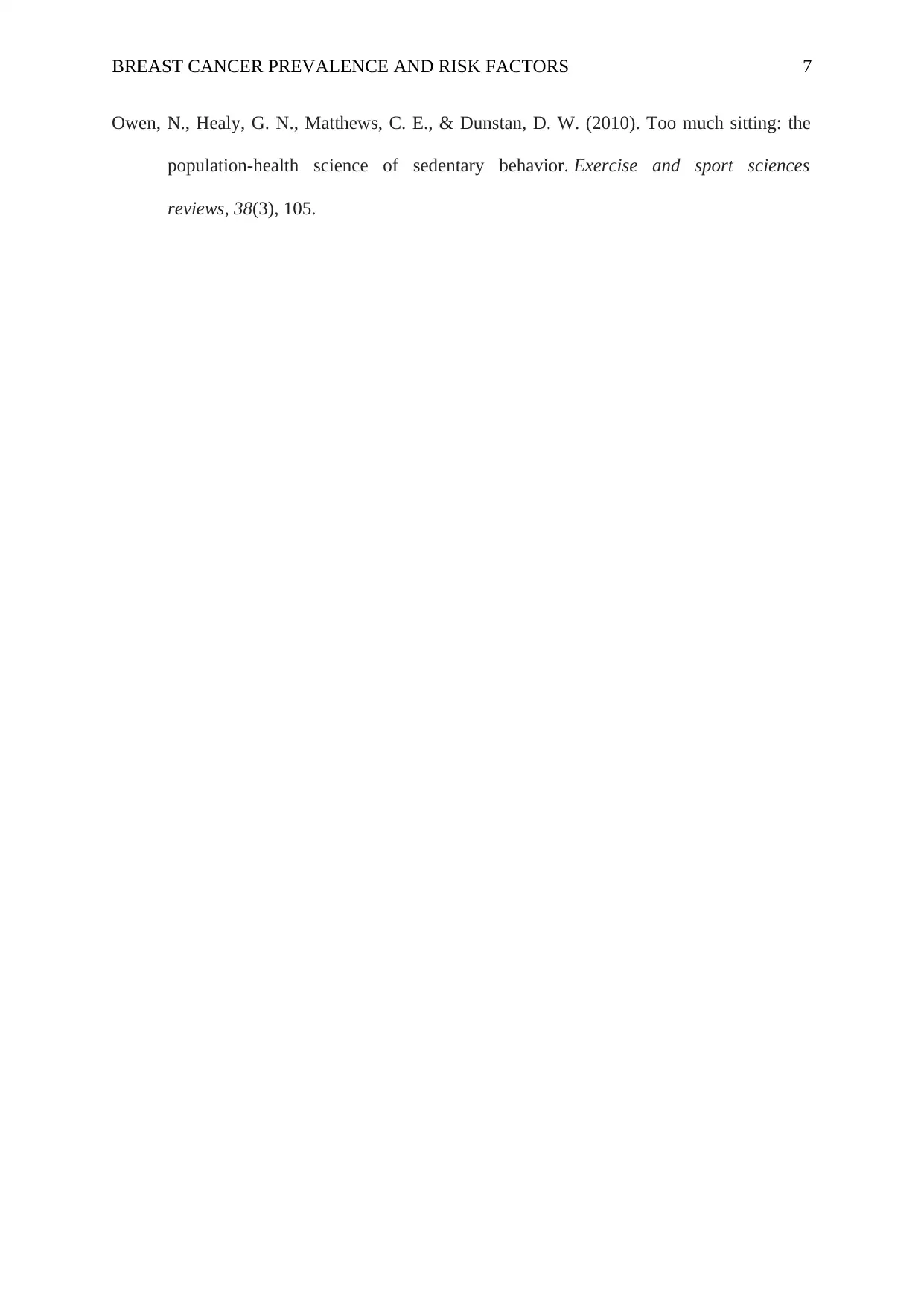
BREAST CANCER PREVALENCE AND RISK FACTORS 7
Owen, N., Healy, G. N., Matthews, C. E., & Dunstan, D. W. (2010). Too much sitting: the
population-health science of sedentary behavior. Exercise and sport sciences
reviews, 38(3), 105.
Owen, N., Healy, G. N., Matthews, C. E., & Dunstan, D. W. (2010). Too much sitting: the
population-health science of sedentary behavior. Exercise and sport sciences
reviews, 38(3), 105.
1 out of 7
Related Documents
Your All-in-One AI-Powered Toolkit for Academic Success.
+13062052269
info@desklib.com
Available 24*7 on WhatsApp / Email
![[object Object]](/_next/static/media/star-bottom.7253800d.svg)
Unlock your academic potential
Copyright © 2020–2025 A2Z Services. All Rights Reserved. Developed and managed by ZUCOL.





